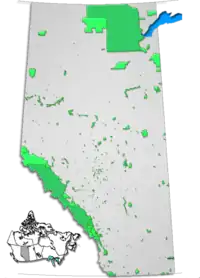List of National Historic Sites of Canada in Alberta
This is a list of National Historic Sites (French: Lieux historiques nationaux) in the province of Alberta. As of March 2018, there are 61 National Historic Sites designated in Alberta, 15 of which are administered by Parks Canada (identified below by the beaver icon ![]() ).[1][2] The first three sites in Alberta were designated in 1923: the site of rival trading posts Fort Augustus and Fort Edmonton, the site of the Frog Lake Massacre and the site of the first outpost of the North-West Mounted Police in Western Canada at Fort Macleod.[3]
).[1][2] The first three sites in Alberta were designated in 1923: the site of rival trading posts Fort Augustus and Fort Edmonton, the site of the Frog Lake Massacre and the site of the first outpost of the North-West Mounted Police in Western Canada at Fort Macleod.[3]
Numerous National Historic Events also occurred across Alberta, and are identified at places associated with them, using the same style of federal plaque which marks National Historic Sites. Several National Historic Persons are commemorated throughout the province in the same way.
This list uses names designated by the Historic Sites and Monuments Board of Canada, which may differ from other names for these sites.
National Historic Sites
| Site | Date(s) | Designated | Location | Description | Image |
|---|---|---|---|---|---|
| Abbot Pass Refuge Cabin |
1922 (completed) | 1992 | Abbot Pass 51°21′50.6″N 116°17′24.75″W |
An alpine hut located at an elevation of 2925 metres in the Alberta Rockies, near the continental divide in Banff National Park, near its boundary with Yoho National Park in British Columbia |  |
| Áísínai'pi [5] | 2004 | Milk River 49°4′55″N 111°37′1″W |
Also known as Writing-on-Stone Provincial Park, it serves as both a nature preserve and protection for a large number of aboriginal rock carvings and paintings | 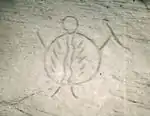 | |
| Athabasca Pass |
1811 (first documented by non-Aboriginal people) | 1971 | Jasper National Park 52°22′35″N 118°11′00″W |
A major point on the fur trade route between Rupert's Land and the Columbia District, used by the York Factory Express | 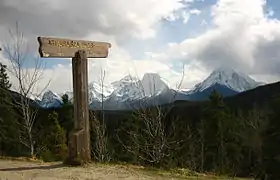 |
| Atlas No. 3 Coal Mine [7] | 1936 (opened) | 2001 | Drumheller 51°19′43.07″N 112°28′57.04″W |
An exceptionally well-preserved coal-mining landscape | 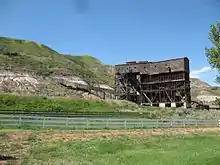 |
| Banff Park Museum |
1903 (completed) | 1985 | Banff National Park 51°10′25.57″N 115°34′17.9″W |
A rustic log-faced building set prominently within a landscaped park in the Banff townsite, containing early botanical and zoological exhibits from Banff National Park in early twentieth-century glass cases |  |
| Banff Springs Hotel [9] | 1928 (completed) | 1988 | Banff National Park 51°09′52.2″N 115°33′47.7″W |
A former railway hotel constructed in Scottish Baronial style at the base of Sulphur Mountain, built to replace a wooden 1888 hotel which burned down in 1926 |  |
| Bar U Ranch |
1882 (established) | 1989 | Longview 50°25′11″N 114°14′0″W |
A historic ranch in the Alberta foothills | |
| Beaulieu [11] | 1891 (completed) | 1992 | Calgary 51.04043°N 114.07835°W |
Known as Lougheed House, a mansion in Calgary's Beltline district originally built for Senator James Alexander Lougheed |  |
| Blackfoot Crossing [12] | 1877 (treaty) | 1925 | Cluny 50°48′15″N 112°54′23″W |
A traditional meeting place on the Blackfoot reserve, where representations of the Crown and the Siksika, Northern Peigan, Kainai, Nakoda and Tsuu T'ina peoples met to sign Treaty 7 in 1877 | 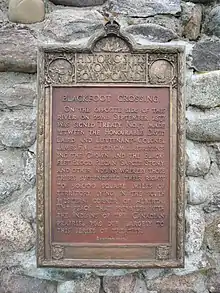 |
| British Block Cairn [13] | 1400 CE (ca.) | 1973 | Canadian Forces Base Suffield 50°36′30.24″N 110°35′32.28″W |
A large boulder cairn surrounded by a ring of stones, an important example of Niitsitapi cultural heritage |  |
| Brooks Aqueduct [14] | 1914 (completed) | 1983 | Brooks 50°31′44.04″N 111°51′18″W |
A landmark irrigation project built by the Canadian Pacific Railway, spanning a 3.2 kilometre valley and irrigating a section of south-eastern Alberta | 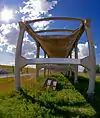 |
| Calgary City Hall [15] | 1911 (completed) | 1984 | Calgary 51°2′46″N 114°3′26″W |
A four-storey sandstone building with central clock tower, designed in the Romanesque Revival style and serving as the focal point of Calgary's city hall complex | 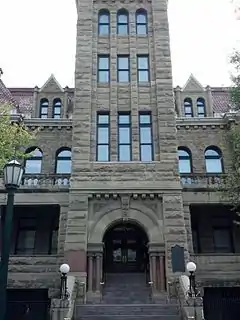 |
| Cave and Basin |
1859 (first documented by non-Aboriginal people) | 1981 | Banff National Park 51°10′12″N 115°35′20.76″W |
The site of natural thermal mineral springs around which Canada's first national park, Banff National Park, was established |  |
| Central Memorial Library and Park[17] | 1889 | 2018 | Calgary 51°02′28.1″N 114°04′14.9″W |
Formal gardens with memorials and a striking Carnegie library; symbol of quest for an attractive, cultured new city in the West | 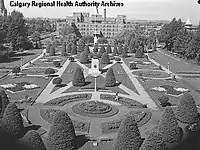 |
| Coleman [18] | 1903 (establishment of townsite) | 2001 | Crowsnest Pass (municipality) 49°38′7″N 114°30′11″W |
A preserved coal-mining landscape in one of the most important coal producing centres in the Crowsnest Pass, the greatest coalfield in Alberta and southeastern British Columbia |  |
| Earthlodge Village[19] | 1740 (c.) | 1972 | Gleichen 50°47′4″N 112°51′25″W |
Earthwork defensive fortifications, unique in Canada, constructed by an unidentified people |  |
| First Oil Well in Western Canada |
1902 | 1965 | Waterton Lakes National Park 49°4′15.53″N 113°59′12.37″W |
First commercially productive oil well in Western Canada | 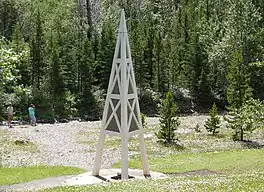 |
| Fort Assiniboine [21] | 1823 (fort established) | 1935 | Woodlands County 54°20′1″N 114°46′19″W |
A trading post established by the Hudson's Bay Company which served as a stopping point along the Klondike Trail |  |
| Fort Augustus and Fort Edmonton [22][23] | 1795 (Fort Augustus built), 1796 (first Fort Edmonton built) | 1923 | Fort Saskatchewan 53°42′58″N 113°13′15″W |
The site of rival trading posts established by the North West Company and the Hudson's Bay Company, described as being a "musket-shot" apart |  |
| Fort Calgary [24] | 1875 (established) | 1925 | Calgary 51°2′43″N 114°2′45″W |
A fort established by the North-West Mounted Police, located at the confluence of the Bow and Elbow rivers in what is now Calgary |  |
| Fort Chipewyan [25] | 1788 (established) | 1930 | Wood Buffalo 58°42′44″N 111°08′54″W |
One of the oldest European settlements in Alberta, established by the North West Company when it built a trading post there in 1788 | |
| Fort Dunvegan [26] | 1805 (established) | 1947 | Dunvegan 55°55′25″N 118°35′40″W |
Site of a trading post established by the North West Company | 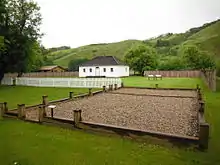 |
| Fort Edmonton III [27] | 1830 (established) | 1959 | Edmonton 53°32′1.37″N 113°30′23.51″W |
The final Hudson's Bay Company fort to bear the "Fort Edmonton" name, evolved into present-day Edmonton; a reconstruction of fort was built several kilometres from the site, and forms a part of Fort Edmonton Park | 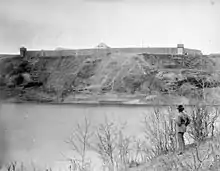 |
| Fort Fork [28] | 1792 (established) | 1928 | Peace River 56°8′15″N 117°28′30″W |
Starting point of Alexander MacKenzie's route to Pacific, 1793 | 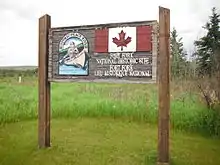 |
| Fort Macleod [29] | 1874 (established) | 1923 | Fort Macleod 49°43′32.1″N 113°23′51.1″W |
A fort established in 1874 on an island on the Oldman River, it was the first outpost of the North-West Mounted Police in Western Canada, and served as NWMP headquarters between 1874 and 1878 | |
| Fort Vermilion [30] | 1788 (first fort established), 1828 (fort moved), 1908 (Old Bay House completed) | 1968 | Fort Vermilion 58°23′4″N 116°2′26″W |
The "Old Bay House" is the only Hudson’s Bay Company factor’s house on its original location in Alberta, the last remaining structure of the fort that evolved into the present-day hamlet of Fort Vermilion | .JPG.webp) |
| Fort Whoop-Up [31][32] | 1870 (established) | 1963 | Lethbridge 49°41′31″N 112°51′24″W |
Originally named Fort Hamilton, the Fort Whoop-Up trading post became the centre of the illegal whisky trade in the region, contributing to the formation of the North-West Mounted Police in 1874 to police Canada's western territories | 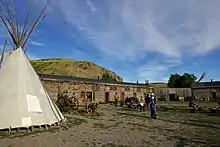 |
| Frog Lake |
1885 (uprising) | 1923 | Frog Lake 53.831186°N 110.358696°W |
Site of the Frog Lake Massacre, a Cree uprising during the North-West Rebellion prompted by what seemed to be unfair treaties by the Canadian government and the dwindling buffalo population | 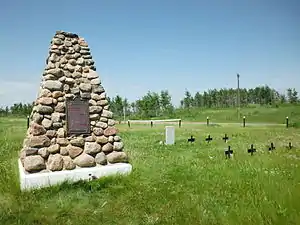 |
| Government House in Edmonton, Alberta [34] | 1911 (completed) | 2012 | Edmonton 53°32′29.88″N 113°32′38.1″W |
Served as official residence of Alberta's first six Lieutenant Governors; its imposing exterior, prominent location and distinctive architecture symbolize Alberta's new provincial status and Edmonton’s new role as capital in the early 20th century |  |
| Head-Smashed-In Buffalo Jump [35] | 3500 BCE (ca.) (usage began), 1880s (first documented by non-Aboriginal people) | 1968 | Municipal District of Willow Creek No. 26 49°42′0″N 113°38′0″W |
A buffalo jump located where the foothills of the Rocky Mountains begin to rise from the prairie, used for 5,500 years by the indigenous peoples of the plains to kill buffalo by driving them off the 11-metre-high cliff (A UNESCO World Heritage Site) | 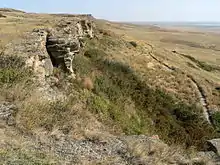 |
| Heritage Hall - Southern Alberta Institute of Technology [36] | 1922 (completed) | 1987 | Calgary 51°03′43″N 114°05′29″W |
A three-storey educational building prominently situated on the brow of the Bow River valley, constructed in the Collegiate Gothic style, representative of the growth of post-secondary educational institutions in Canada in the early twentieth century |  |
| Howse Pass |
1807 (first European exploration) | 1978 | Blaeberry River and Banff National Park 51°48′53.53″N 116°46′20.31″W |
An early nineteenth-century transportation route through the Canadian Rockies |  |
| Jasper House |
1830 (completed) | 1924 | Jasper National Park 53°8′48.51″N 117°59′3.1″W |
Archaeological remains of a fur trade post that served as a major destination for travellers using the Athabasca and the Yellowhead passes and the First Nations route through the Smoky River Pass. | |
| Jasper Park Information Centre |
1914 (completed) | 1992 | Jasper National Park 52°52′38.32″N 118°4′51.01″W |
A rustic fieldstone park building, symbolic of early architecture within Canada's national parks | |
| Lac Ste. Anne Pilgrimage [40] | 1889 (established) | 1984 | Lac Ste. Anne County 53°42′40″N 114°23′49″W |
First Roman Catholic mission to be established by the renowned priest, Albert Lacombe |  |
| Leduc-Woodbend Oilfield [41] | 1946 (established) | 1990 | Leduc 53°19′46.45″N 113°43′31.01″W |
Site of a major crude oil discovery in Alberta, which led to the post-World War II boom in petroleum exploration and development in Western Canada | 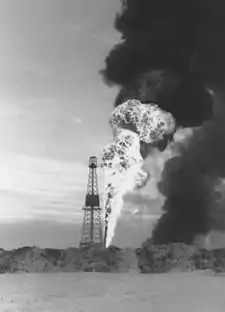 |
| Maligne Lake Chalet and Guest House |
1935 (built) | 2015 | Jasper National Park 52.729652°N 117.639632°W |
Rustic lodge evokes early mountain tourism and the role of guides, outfitters and railroads in the development of national parks | |
| Medalta Potteries [43] | 1912 (established) | 1985 | Medicine Hat 50°1′55″N 110°38′58″W |
Early twentieth century beehive kilns and manufacturing buildings; the first western Canadian manufacturer to ship goods east of the Great Lakes |  |
| Medicine Hat Clay Industries [44] | 1999 | Medicine Hat 50°1′53″N 110°39′3″W |
A cultural landscape illustrating the factors (local clay beds, access to railway transportation, vast supplies of natural gas to fire the kilns) that led to Medicine Hat’s emergence as the largest supplier of clay products west of Ontario |  | |
| Mewata Drill Hall / Calgary Drill Hall [45] | 1918 (completed) | 1989 | Calgary 51°02′45″N 114°05′20″W |
A large-scale drill hall, the scale and prominent location of which exemplify the national pride that greeted Canada's strong performance in the South African War and the First World War |  |
| Nordegg [46] | 1911 (mine established) | 2001 | Nordegg 52°28′30″N 116°4′24″W |
An important coal mining landscape, with many mining and related resources still existing on site |  |
| Notre Dame des Victoires / Lac La Biche Mission [47] | 1853 (established) | 1989 | Lac La Biche 54°49′15″N 112°5′44″W |
An important Roman Catholic mission, established by the Oblates of Mary Immaculate, which served as the hub of various portage routes | 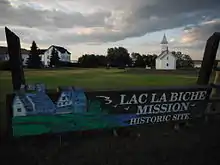 |
| Old Women's Buffalo Jump [48] | 1960 | Cayley | An aboriginal bison drive in use for more than 1500 years |  | |
| Palace Theatre [49] | 1921 (completed) | 1996 | Calgary | A movie palace designed by internationally renowned theatre architect C. Howard Crane, and one of four surviving movie theatres in Canada built by the Allen Chain | .jpg.webp) |
| Prince of Wales Hotel [50] | 1927 (completed) | 1992 | Waterton Lakes National Park 49°03′32″N 113°54′13″W |
A landmark hotel constructed in the rustic-design style, representing the golden age of railway resort development in Canada's national parks |  |
| Reader Rock Garden[51] | 1913 (begun) | 2018 | Calgary 51.0299°N 114.055°W |
Scientific and aesthetic horticultural garden | .jpg.webp) |
| Rocky Mountain House |
1799 (established) | 1926 | Rocky Mountain House, Alberta 52.361495°N 114.970471°W |
An archaeological site that contains the remains of several early 19th-century fur trade forts known by the names of Rocky Mountain House (established by the North West Company) and Acton House (established by the Hudson's Bay Company) | 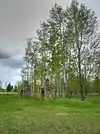 |
| Rundle's Mission [53] | 1847 (established) | 1963 | Pigeon Lake 53.025°N 114.067°W |
The site of the first Protestant mission in the Canadian Prairies | 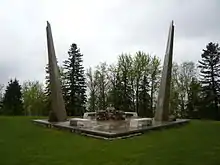 |
| Skoki Ski Lodge |
1936 (completed) | 1992 | Banff National Park 51°31′23″N 116°04′35″W |
A rustic ski lodge resort, representing the early visual identity of Canada's mountain parks and of the early days of tourism in Banff National Park | 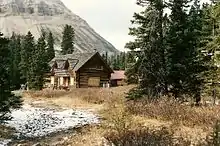 |
| St. Patrick's Roman Catholic Church [55] | 1914 (completed) | 1990 | Medicine Hat 50°2′43″N 110°40′50″W |
A noted example of Gothic Revival architecture in Alberta |  |
| Stephen Avenue [56] | 1880 (established) | 2002 | Calgary 51.0456°N 114.0630°W |
A late-nineteenth-century retail streetscape in downtown Calgary | 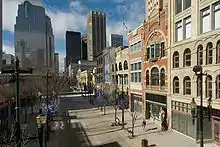 |
| Stirling Agricultural Village [57] | 1899 (established) | 1997 | Stirling | The best surviving example of a Mormon agricultural village in Canada, following the Plat of Zion model | 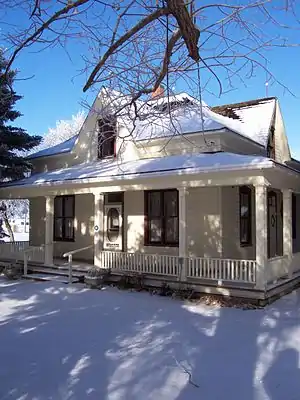 |
| Suffield Tipi Rings [58] | 1973 | Cypress County | Various sets of archaeological remains relating to the cultural occupations by the Niitsitapi, featuring tipi rings, medicine wheels and other rock arrangements | ||
| Sulphur Mountain Cosmic Ray Station |
1957 (completed) | 1982 | Banff National Park 51°07′25″N 115°33′20″W |
Canada’s most important cosmic ray observatory from the 1950s |  |
| Temple of the Church of Jesus Christ of Latter Day Saints [60] | 1923 (completed) | 1992 | Cardston | A monumental modern temple in historic Mormon centre |  |
| Territorial Court House [61] | 1904 (completed) | 1980 | Fort Macleod | The oldest court house in Alberta and one of the few buildings surviving from the period of Territorial administration of the Canadian Prairies | 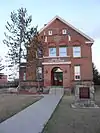 |
| Treaty Nº 7 Signing Site [62] | 1877 (treaty signed) | 1925 | Wheatland County | The site where representatives of the Siksika, Pekuni, Kainai, Nakoda and Tsuu T’ina peoples met with representatives of the Crown to sign Treaty No. 7 in September 1877 |  |
| Turner Valley Gas Plant [63] | 1914 (established) | 1995 | Turner Valley | A petroleum industrial complex comprising 22 metal buildings and related infrastructure, and the site of two early gas wells that established the Turner Valley as the most important oil field in Alberta |  |
| Turner Valley Oilfield [64] | 1914 (established) | 1990 | Turner Valley | The first major oil field in Alberta |  |
| Victoria Settlement [65] | 1863 (established) | 2001 | Smoky Lake | A cultural landscape illustrating major themes in the development of the Canadian Prairies, including the rise of the fur trade, the establishment of the Métis river lot system, the arrival of missions, prairie agricultural development and the arrival of eastern European immigrants |  |
| Wetaskiwin Court House [66] | 1909 (completed) | 1980 | Wetaskiwin | A court house symbolic of the rapid growth of the justice system in Alberta, typifying court house design during this formative period in the growth of western Canada |  |
| Yellowhead Pass |
1971 | Jasper National Park 52°53′33″N 118°27′50″W |
An important transportation route through the Canadian Rockies | 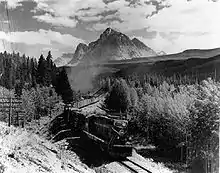 |
See also
| Wikimedia Commons has media related to National Historic Sites of Canada in Alberta. |
References
- "Alberta - National Historic Sites of Canada". Directory of Federal Heritage Designations. Parks Canada. Retrieved 28 March 2013.
- The National Historic Sites of Canada administered by Parks Canada are as follows: Abbot Pass Refuge Cabin, Athabasca Pass, Banff Park Museum, Bar U Ranch, Cave and Basin, First Oil Well in Western Canada, Frog Lake, Howse Pass, Jasper House, Jasper Park Information Centre, Rocky Mountain House, Skoki Ski Lodge, Sulphur Mountain Cosmic Ray Station, and Yellowhead Pass. See Alberta - National Historic Sites of Canada administered by Parks Canada
- Directory of Designations of National Historic Significance of Canada, Parks Canada
- Abbot Pass Refuge Cabin. Canadian Register of Historic Places.
- Áísínai'pi. Canadian Register of Historic Places.
- Athabasca Pass. Canadian Register of Historic Places.
- Atlas No. 3 Coal Mine. Canadian Register of Historic Places.
- Banff Park Museum. Canadian Register of Historic Places.
- Banff Springs Hotel. Canadian Register of Historic Places.
- Bar U Ranch. Canadian Register of Historic Places.
- Beaulieu. Canadian Register of Historic Places.
- Blackfoot Crossing. Directory of Federal Heritage Designations. Parks Canada.
- British Block Cairn. Canadian Register of Historic Places.
- Brooks Aqueduct. Canadian Register of Historic Places.
- Calgary City Hall. Canadian Register of Historic Places.
- Cave and Basin. Canadian Register of Historic Places.
- Government of Canada Announces New National Historic Designations, Parks Canada news release, January 12, 2018
- Coleman. Canadian Register of Historic Places.
- Earthlodge Village. Directory of Federal Heritage Designations. Parks Canada. Retrieved 25 November 2013.
- First Oil Well in Western Canada. Canadian Register of Historic Places.
- Fort Assiniboine. Directory of Federal Heritage Designations. Parks Canada. Retrieved 25 November 2013.
- Fort Augustus and Fort Edmonton. Canadian Register of Historic Places. Retrieved 25 November 2013.
- "Fort Edmonton and Fort Augustus". Alberta Online Encyclopedia. Heritage Community Foundation. Retrieved 24 May 2010.
- Fort Calgary. Canadian Register of Historic Places.
- Fort Chipewan. Canadian Register of Historic Places. Retrieved 25 November 2013.
- Fort Dunvegan. Canadian Register of Historic Places. Retrieved 25 November 2013.
- Fort Edmonton III. Directory of Federal Heritage Designations. Parks Canada.
- Fort Fork. Canadian Register of Historic Places.
- Fort Macleod. Canadian Register of Historic Places.
- Fort Vermilion. Canadian Register of Historic Places.
- History, Fort Whoop-up
- Fort Whoop-Up. Canadian Register of Historic Places.
- Frog Lake. Canadian Register of Historic Places.
- Government House in Edmonton, Alberta. Directory of Federal Heritage Designations. Parks Canada. Retrieved 27 March 2013.
- Head-Smashed-In Buffalo Jump. Directory of Federal Heritage Designations. Parks Canada.
- Heritage Hall - Southern Alberta Institute of Technology. Canadian Register of Historic Places.
- Howse Pass. Canadian Register of Historic Places. Retrieved 22 January 2012.
- Jasper House. Canadian Register of Historic Places.
- Jasper Park Information Centre. Canadian Register of Historic Places.
- Lac Ste. Anne Pilgrimage. Canadian Register of Historic Places.
- Leduc-Woodbend Oilfield. Canadian Register of Historic Places.
- Parks Canada news release, March 17, 2015
- Medalta Potteries. Canadian Register of Historic Places.
- Medicine Hat Clay Industries. Canadian Register of Historic Places.
- Mewata Drill Hall / Calgary Drill Hall. Canadian Register of Historic Places.
- Nordegg. Canadian Register of Historic Places.
- Notre Dame des Victoires / Lac La Biche Mission. Canadian Register of Historic Places.
- Old Women's Buffalo Jump. Directory of Federal Heritage Designations. Parks Canada.
- Palace Theatre. Canadian Register of Historic Places.
- Prince of Wales Hotel. Canadian Register of Historic Places.
- Government of Canada Announces 12 New National Historic Designations, Parks Canada news release, March 27, 2018
- Rocky Mountain House. Canadian Register of Historic Places.
- Rundle's Mission. Canadian Register of Historic Places.
- Skoki Ski Lodge. Canadian Register of Historic Places.
- St. Patrick's Roman Catholic Church. Canadian Register of Historic Places.
- Stephen Avenue. Canadian Register of Historic Places.
- Stirling Agricultural Village. Canadian Register of Historic Places.
- Suffield Tipi Rings. Canadian Register of Historic Places.
- Sulphur Mountain Cosmic Ray Station. Canadian Register of Historic Places.
- Temple of the Church of Jesus Christ of Latter Day Saints. Canadian Register of Historic Places.
- Territorial Court House. Canadian Register of Historic Places.
- Treaty No. 7 Signing Site. Canadian Register of Historic Places.
- Turner Valley Gas Plant. Canadian Register of Historic Places.
- Turner Valley Oilfield. Directory of Federal Heritage Designations. Parks Canada.
- Victoria Settlement. Canadian Register of Historic Places.
- Wetaskiwin Court House. Canadian Register of Historic Places.
- Yellowhead Pass. Canadian Register of Historic Places.
